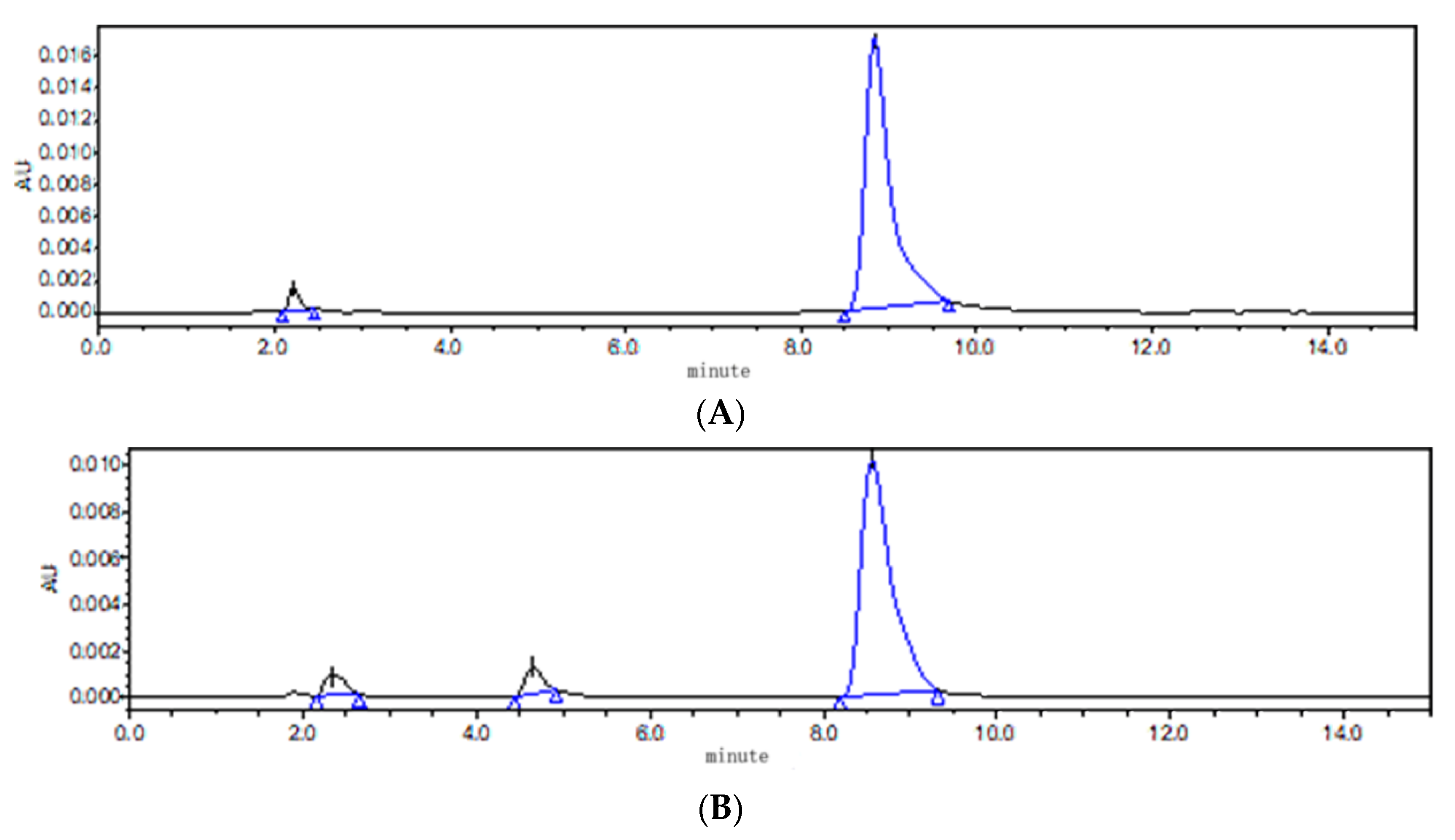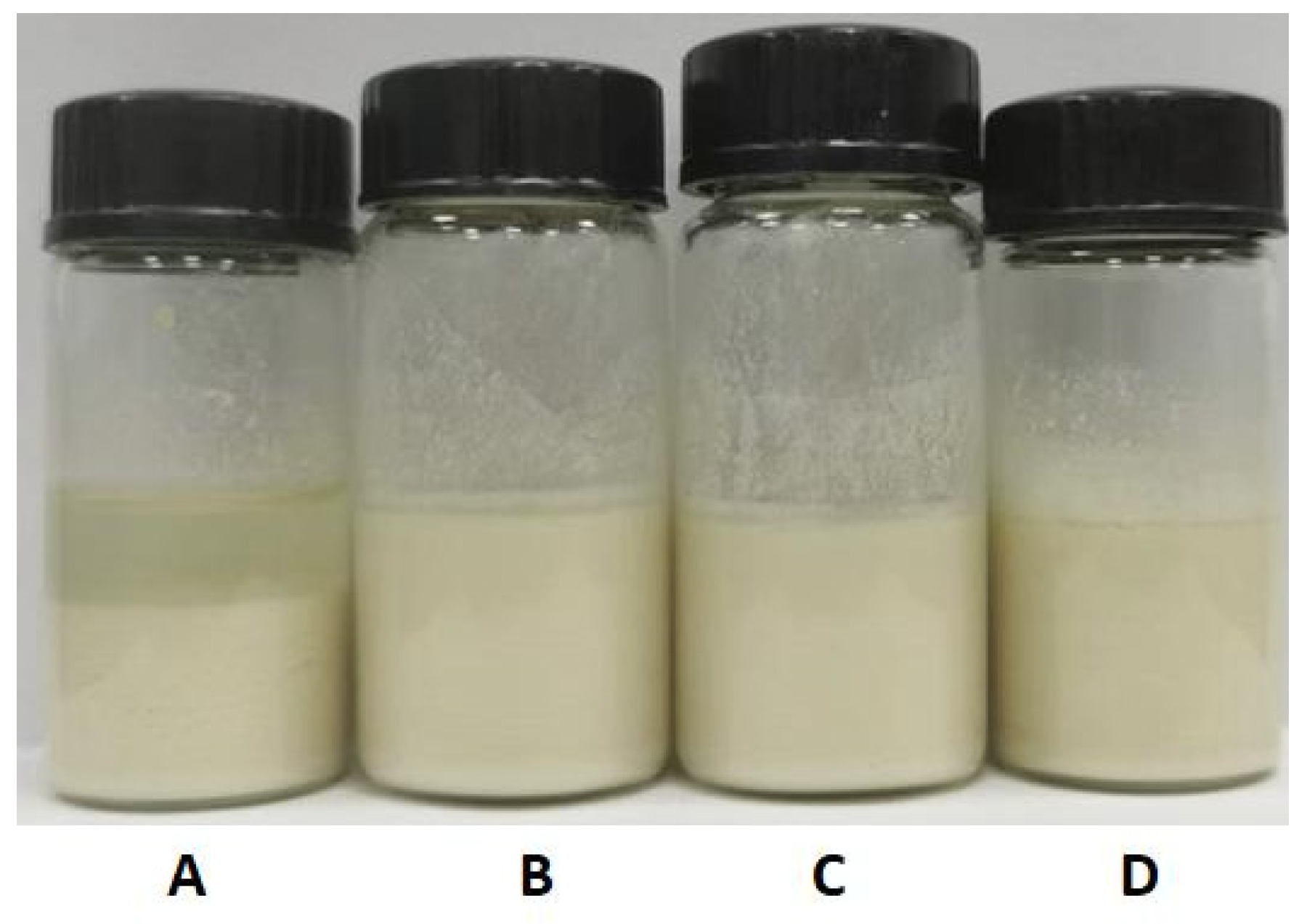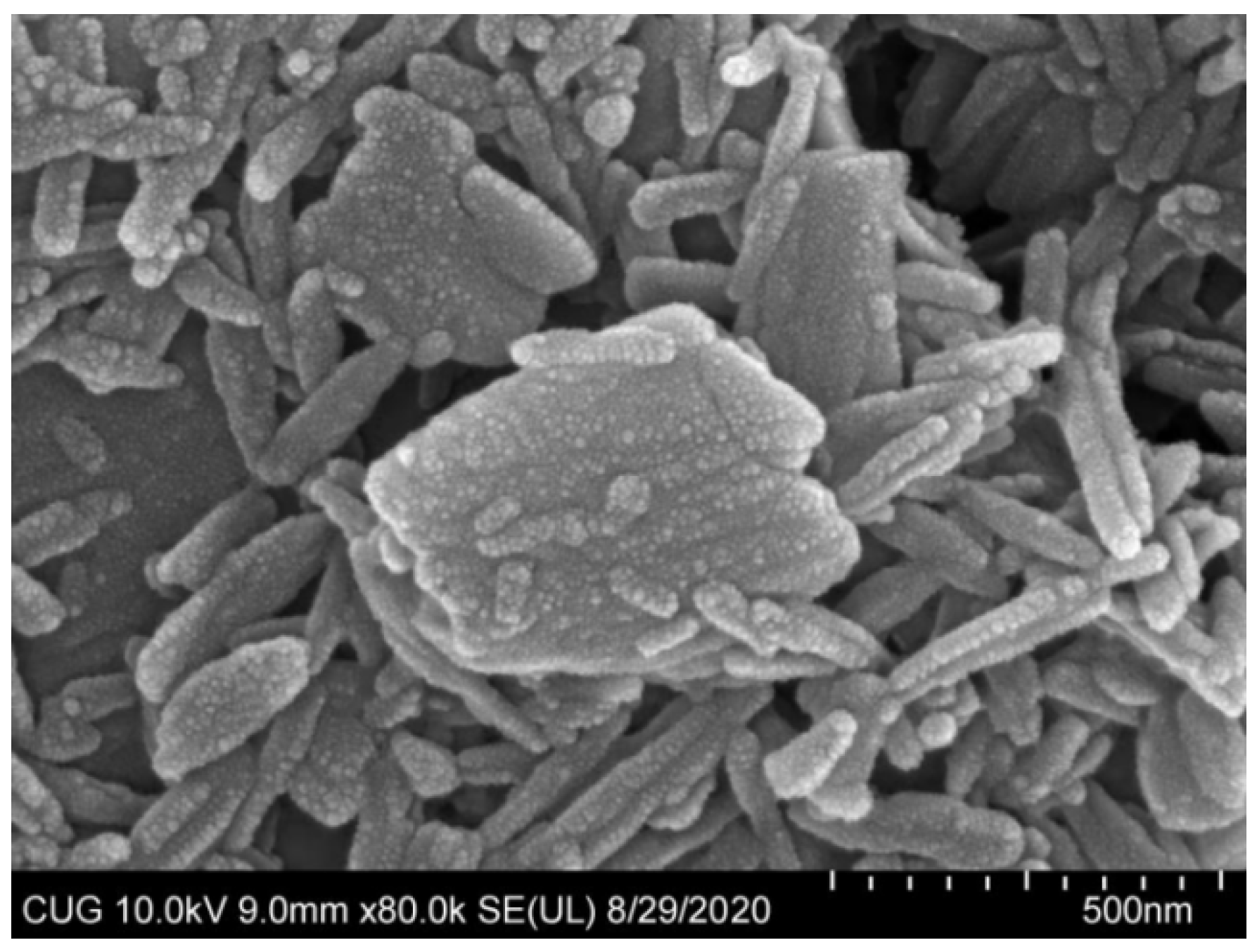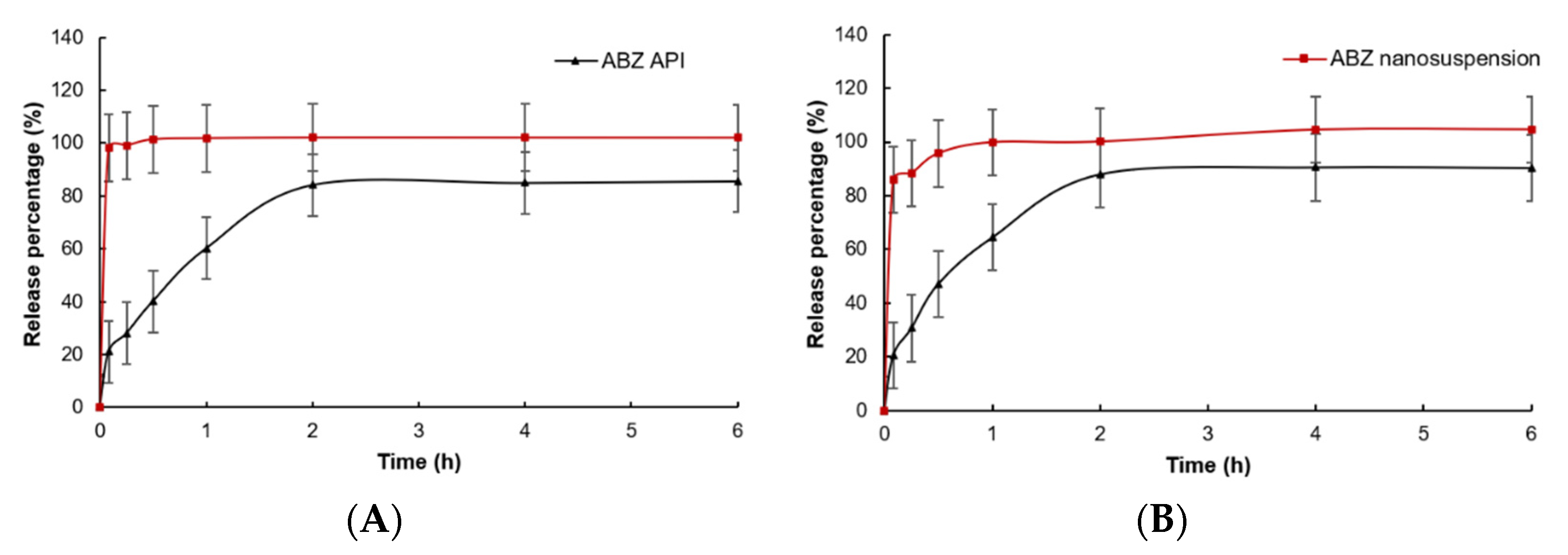Nanocrystal Suspensions for Enhancing the Oral Absorption of Albendazole
Abstract
:1. Introduction
2. Materials and Methods
2.1. Preparation of ABZ Nanocrystal Suspension
2.2. Characterization of the ABZ Nanocrystals
2.2.1. Scanning Electron Microscopy (SEM)
2.2.2. Determination of Size, Polydispersity Index (PDI) and Zeta Potential of Nanocrystals
2.2.3. Differential Scanning Calorimetry (DSC)
2.2.4. X-ray Diffraction (XRD) Study
2.2.5. Sedimentation Rate, Redispersibility and pH
2.2.6. Content Determination
2.3. Solubility
2.4. In Vitro Dissolution
2.5. Pharmacokinetics Study
2.6. HPLC Assay
2.7. Statistical Analysis
3. Results
3.1. Effect of Cosolvent on the Stability of ABZ Nanosuspension
3.2. Effect of Stabilizer on the Stability of ABZ Nanosuspension
3.3. Properties of ABZ Nanosuspensions
3.4. Identification
3.5. Equilibrium Solubility of ABZ Nanosuspension
3.6. In Vitro Dissolution
3.7. Pharmacokinetics of ABZ Nanocrystals
4. Discussion
5. Conclusions
Author Contributions
Funding
Institutional Review Board Statement
Informed Consent Statement
Data Availability Statement
Conflicts of Interest
References
- Morris, D.L. Preoperative albendazole therapy for hydatid cyst. Br. J. Surg. 1987, 74, 805–806. [Google Scholar] [CrossRef]
- Gil-Grande, L.A.; Sánchez-Ruano, J.; García-Hoz, F.; Bárcena, R.; Rodriguez-Caabeiro, F.; Brasa, C.; Casado, N.; Prieto, J.G.; Alvarez, A.I.; Aguilar, L.; et al. Randomised controlled trial of efficacy of albendazole in intra-abdominal hydatid disease. Lancet 1993, 342, 1269–1272. [Google Scholar] [CrossRef]
- Zulu, I.; Veitch, A.; Sianongo, S.; McPhail, G.; Feakins, R.; Farthing, M.J.G.; Kelly, P. Albendazole chemotherapy for AIDS-related diarrhoea in Zambia-clinical; parasitological and mucosal responses. Aliment. Pharm. Ther. 2002, 16, 595–601. [Google Scholar] [CrossRef]
- Venkatesan, P. Albendazole. J. Antimicrob. Chemother. 1998, 41, 145–147. [Google Scholar] [CrossRef]
- Del Brutto, O.H. Current approaches to cysticidal drug therapy for neurocysticercosis. Expert Rev. Anti. Infect. Ther. 2020, 18, 789–798. [Google Scholar] [CrossRef]
- Nery, S.V.; McCarthy, J.S.; Traub, R.; Andrews, R.M.; Black, J.; Gray, D.; Weking, E.; Atkinson, J.-A.; Campbell, S.; Francis, N.; et al. A cluster-randomised controlled trial integrating a community-based water; sanitation and hygiene programme; with mass distribution of albendazole to reduce intestinal parasites in Timor-Leste, the WASH for WORMS research protocol. BMJ Open 2015, 5, e9293. [Google Scholar] [CrossRef]
- Abate, E.; Elias, D.; Getachew, A.; Alemu, S.; Diro, E.; Britton, S.; Aseffa, A.; Stendahl, O.; Schön, T. Effects of albendazole treatment on the clinical outcome and immunological responses in patients with helminth infection and pulmonary tuberculosis, a randomized clinical trial. Med. Health Sci. 2013, 61, 91827. [Google Scholar]
- Moro, P.; Schantz, P.M. Echinococcosis, a review. Int. J. Infect. Dis. 2009, 13, 125–133. [Google Scholar] [CrossRef]
- Wen, H.; New, R.R.C.; Muhmut, M.; Wang, J.H.; Wang, Y.H.; Zhang, J.H.; Shao, Y.M.; Craig, P.S. Pharmacology and efficacy of liposome-entrapped albendazole in experimental secondary alveolar echinococcosis and effect of co-administration with cimetidine. Parasitology 1996, 113, 111–121. [Google Scholar] [CrossRef]
- Castillo, J.; Palomo-Canales, J.; Garcia, J.; Lastres, J.; Bolas, F.; Torrado, J. Preparation and characterization of albendazole β-cyclodextrin complexes. Drug Dev. Ind. Pharm. 1999, 25, 1241–1247. [Google Scholar] [CrossRef]
- Martinez-Marcos, L.; Lamprou, D.A.; McBurney, R.T.; Halbert, G.W. A novel hot-melt extrusion formulation of albendazole for increasing dissolution properties. Int. J. Pharm. 2016, 499, 175–185. [Google Scholar] [CrossRef] [PubMed] [Green Version]
- McGuckin, M.B.; Wang, J.W.; Ghanma, R.; Qin, N.; Palma, S.D.; Donnelly, R.F.; Paredes, A.J. Nanocrystals as a master key to deliver hydrophobic drugs via multiple administration routes. J. Control. Release 2022, 345, 334–353. [Google Scholar] [CrossRef] [PubMed]
- Rabinow, B.E. Nanosuspensions in drug delivery. Nat. Rev. Drug Discov. 2004, 3, 785–796. [Google Scholar] [CrossRef] [PubMed]
- Kesisoglou, F.; Panmai, S.; Wu, Y. Nanosizing-oral formulation development and biopharmaceutical evaluation. Adv. Drug Deliver. Rev. 2007, 59, 631–644. [Google Scholar] [CrossRef]
- Müller, R.; Jacobs, C.; Kayser, O. Nanosuspensions as particulate drug formulations in therapy, rationale for development and what we can expect for the future. Adv. Drug Deliver. Rev. 2001, 47, 3–19. [Google Scholar] [CrossRef]
- Sattar, A.; Chen, D.; Jiang, L.; Pan, Y.; Tao, Y.; Huang, L.; Liu, Z.; Xie, S.; Yuan, Z. Preparation; characterization and pharmacokinetics of cyadox nanosuspension. Sci. Rep. 2007, 7, 2289. [Google Scholar] [CrossRef]
- Sun, Y.Z.; Chen, D.M.; Zhao, Y.; Zhou, K.X.; Zhang, B.; Wang, H.T.; Xie, S.Y. Exploitation of nanocrystal suspension as an effective oral formulation for oxfendazole. Drug Deliv. Transl. Res. 2022, 12, 1219–1229. [Google Scholar] [CrossRef]
- Mohammad, I.S.; Hu, H.Y.; Yin, L.F.; He, W. Drug nanocrystals, Fabrication methods and promising therapeutic applications. Int. J. Pharm. 2019, 562, 187–202. [Google Scholar] [CrossRef]
- Pensel, P.; Paredes, A.J.; Albani, C.M.; Allemandi, D.; Bruni, S.S.; Palma, S.D.; Elissondo, M.C. Albendazole nanocrystals in experimental alveolar echinococcosis, Enhanced chemoprophylactic and clinical efficacy in infected mice. Vet. Parasitol. 2018, 251, 78–84. [Google Scholar] [CrossRef]
- Paredes, A.J.; Camacho, N.M.; Schofs, L.; Dib, A.; Zarazaga, M.P.; Litterio, N.; Allemandi, D.A.; Bruni, S.S.; Lanusse, C.; Palma, S.D. Ricobendazole nanocrystals obtained by media milling and spray drying, Pharmacokinetic comparison with the micronized form of the drug. Int. J. Pharm. 2020, 585, 119501. [Google Scholar] [CrossRef]
- Paredes, A.J.; Litterio, N.; Dib, A.; Allemandi, D.A.; Lanusse, C.; Bruni, S.S.; Palma, S.D. A nanocrystal-based formulation improves the pharmacokinetic performance and therapeutic response of albendazole in dogs. J. Pharm. Pharmacol. 2018, 70, 51–58. [Google Scholar] [CrossRef] [PubMed]
- Paredes, A.J.; Bruni, S.S.; Allemandi, D.; Lanusse, C.; Palma, S.D. Albendazole nanocrystals with improved pharmacokinetic performance in mice. Ther. Deliv. 2018, 9, 89–97. [Google Scholar] [CrossRef]
- Hu, C.H.; Liu, Z.S.; Liu, C.Y.; Zhang, Y.G.; Fan, H.N.; Qian, F. Improvement of Antialveolar Echinococcosis Efficacy of Albendazole by a Novel Nanocrystalline Formulation with Enhanced Oral Bioavailability. ACS Infect. Dis. 2019, 6, 802–810. [Google Scholar] [CrossRef] [PubMed]
- Koradia, D.K.; Parikh, H.R. Dissolution enhancement of albendazole through nanocrystal formulation. J. Pharm. Bioall. Sci. 2012, 4, 62–63. [Google Scholar] [CrossRef] [PubMed]
- Permana, A.D.; Paredes, A.J.; Zanutto, F.V.; Amir, M.N.; Ismail, I.; Bahar, M.A.; Sumarheni, P.S.D.; Donnelly, R.F. Albendazole Nanocrystal-Based Dissolving Microneedles with Improved Pharmacokinetic Performance for Enhanced Treatment of Cystic Echinococcosis. ACS App. Mater. Inter. 2021, 13, 38745–38760. [Google Scholar] [CrossRef]
- Lopez-Vidal, L.; Real, J.P.; Real, D.A.; Camacho, N.; Kogan, M.J.; Paredes, A.J.; Palma, S.D. Nanocrystal-based 3D-printed tablets, Semi-solid extrusion using melting solidification printing process (MESO-PP) for oral administration of poorly soluble drugs. Int. J. Pharm. 2022, 611, 121311. [Google Scholar] [CrossRef]
- Paredes, A.J.; Llabot, J.M.; Bruni, S.S.; Allemandi, D.; Palma, S.D. Self-dispersible nanocrystals of albendazole produced by high pressure homogenization and spray-drying. Drug Dev. Ind. Pharm. 2016, 42, 1564–1570. [Google Scholar] [CrossRef]
- Craing, P.S. Current research in eahinococcosis. Parasitol. Today 1994, 10, 209–210. [Google Scholar] [CrossRef]
- Morris, D.L.; Clarkson, M.J.; Stallbaumer, M.F.; Pritchard, J.; Jones, R.S.; Chinnery, J.B. Albendazole treatment os pulmonary hydatid cysts in naturally infected sheep: A study with relevance to the treatment of hydatid cysts in man. Thorax 1985, 40, 453–458. [Google Scholar] [CrossRef]
- Rowe, R.C.; Sheskey, P.J.; Weller, P.J.; Rowe, R.; Sheskey, P.; Weller, P. Handbook of Pharmaceutical Excipients, 4th ed.; Pharmaceutical Press and American Pharmaceutical Association: London, UK, 2003; pp. 271–273. [Google Scholar]
- Shegokar, R.; Müller, R.H. Nanocrystals, industrially feasible multifunctional formulation technology for poorly soluble actives. Int. J. Pharmaceut. 2010, 399, 129–139. [Google Scholar] [CrossRef]
- Lee, J.; Lee, S.J.; Choi, J.Y.; Yoo, J.Y.; Ahn, C.-H. Amphiphilic amino acid copolymers as stabilizers for the preparation of nanocrystal dispersion. Eur. J. Pharm. Sci. 2005, 24, 441–449. [Google Scholar] [CrossRef] [PubMed]
- Rainer, H.M.; Katrin, P. Nanosuspensions for the formulation of poorly soluble drugs, I. Preparation by a size-reduction technique. Int. J. Pharmaceut. 1998, 160, 229–237. [Google Scholar]
- Ji, Y.B.; Gao, Y.X.; Hao, X.; Zhang, X.; Wang, X. Preparation of annonaceous acetogenins nanosuspensions using poloxamer 188 as a stabilizer and their in vitro and in vivo investigation. Acta Pharm. Sin. B 2018, 53, 2113–2121. [Google Scholar]
- Zhang, J.; Bunker, M.; Parker, A.; Madden-Smith, C.E.; Patel, N.; Roberts, C.J. The stability of solid dispersions of felodipine in polyvinylpyrrolidone characterized by nanothermal analysis. Int. J. Pharmaceut. 2011, 414, 210–217. [Google Scholar] [CrossRef]
- Hilbig, J.; Ma, Q.; Davidson, P.M.; Weiss, J.; Zhong, Q. Physical and antimicrobial properties of cinnamon bark oil co-nanoemulsified by lauric arginate and Tween 80. Int. J. Food Microbiol. 2016, 233, 52–59. [Google Scholar] [CrossRef]
- Kuskov, A.N.; Voskresenskaya, A.A.; Goryachay, A.V. Preparation and characterization of amphiphilic poly-N-vinylpyrrolidone nanoparticles containing indomethacin. J. Mater. Sci. Mater. Med. 2010, 21, 1521–1530. [Google Scholar] [CrossRef]
- Lopes, M.A.; Abrahim-Vieira, B.; Oliveira, C. Probing insulin bioactivity in oral nanoparticles produced by ultrasonication-assisted emulsification/internal gelation. Int. J. Nanomed. 2015, 10, 5865–5880. [Google Scholar]
- Santos, A.C.; Cunha, J.; Veiga, F. Ultrasonication of insulin-loaded microgel particles produced by internal gelation, Impact on particle’s size and insulin bioactivity. Carbohyd. Polym. 2013, 98, 1397–1408. [Google Scholar] [CrossRef]
- Kim, H.Y.; Han, J.A.; Kweon, D.K. Effect of ultrasonic treatments on nanoparticle preparation of acid-hydrolyzed waxy maize starch. Carbohyd. Polym. 2012, 93, 582–588. [Google Scholar] [CrossRef]
- Adhiyaman, R.; Basu, S.K. Modification of dipyridamole using different solvents and crystallisation conditions. Int. J. Pharmaceut. 2006, 321, 27–34. [Google Scholar] [CrossRef]
- Böhm, B.H.; Müller, R.H. Lab-scale production unit design for nanosuspensions of sparingly soluble cytotoxic drugs. Pharm. Sci. Technol. Today 1999, 2, 336–339. [Google Scholar] [CrossRef]
- Lubega, G.W.; Prichard, R.K. Interaction of benzimidazole anthelmintics with Haemonchus contortus tubulin: Binding affinity and anthelmintic efficacy. Exp. Parasitol. 1999, 73, 203–213. [Google Scholar] [CrossRef]
- Zhang, H.; Zhao, J.; Chen, B.; Ma, Y.; Li, Z.; Shou, X.; Wen, L.; Yuan, Y.; Gao, H.; Ruan, J.; et al. Pharmacokinetics and tissue distribution study of liposomal albendazole in naturally Echinococcus granulosus infected sheep by a validated UPLC-Q-TOF-MS method. J. Chromatog. B 2020, 1141, 122016. [Google Scholar] [CrossRef] [PubMed]
- Fabbri, J.; Espinosa, J.P.; Pensel, P.E.; Medici, S.K.; Gamboa, G.U.; Benoit, J.P.; Elissondo, M.C. Do albendazole-loaded lipid nanocapsules enhance the bioavailability of albendazole in the brain of healthy mice? Acta Trop. 2020, 201, 105215. [Google Scholar] [CrossRef]
- Ban, C.; Jo, M.; Park, Y.H.; Kim, J.H.; Han, J.Y.; Lee, K.W.; Kweon, D.-H.; Choi, Y.J. Enhancing the oral bioavailability of curcumin using solid lipid nanoparticles. Food Chem. 2020, 302, 125328. [Google Scholar] [CrossRef]










| ABZ | PVA | Malic Acid | Temperature | Speed | Size (nm) | ZP (mv) | PDI |
|---|---|---|---|---|---|---|---|
| 3 g | 0.25 g | 15.0 g | 80 °C | 2000 rpm/5 min | 508 ± 11.9 | 2.30 ± 0.44 | 0.28 ± 0.01 |
| Solvents | Solubility (µg/mL, Mean ± S.D.) | Enhanced Folds | |
|---|---|---|---|
| Native ABZ | ABZ Nanocrystal | ||
| Water | 3.35 ± 0.10 | 3967 ± 0.05 b | 1189 |
| Ethanol | 11.7 ± 0.00 | 226 ± 0.08 b | 19.4 |
| Acetonitrile | 31.9 ± 0.30 | 282 ± 0.24 b | 8.80 |
| DMF | 7308 ± 0.34 | 16,078 ± 0.42 b | 2.20 |
| Parameters | Units | ABZ | ABZSO | ABZSO2 | Total | ||||
|---|---|---|---|---|---|---|---|---|---|
| Native | Nanosuspension | Native | Nanosuspension | Native | Nanosuspension | Native | Nanosuspension | ||
| Tmax | h | 0.60 ± 0.22 | 0.50 | 5.00 ± 1.15 | 4.67 ± 1.03 b | 8.00 | 7.33 ± 1.03 a | 5.60 ± 1.67 | 5.67 ± 1.51 b |
| Cmax | μg/mL | 0.61 ± 0.06 | 0.66 ± 0.19 | 1.18 ± 0.16 | 2.08 ± 0.38 a | 1.03 ± 0.11 | 1.71 ± 0.30 a | 2.08 ± 0.35 | 3.37 ± 0.82 b |
| AUC0→∞ | h*μg/mL | 14.7 ± 4.04 | 16.4 ± 1.81 a | 31.6 ± 7.49 | 46.1 ± 11.1 a | 30.7 ± 2.25 | 35.9 ± 3.59 a | 725 ± 6.18 | 102 ± 20.8 b |
| VZ | mL/kg | 341 ± 85.5 | 340 ± 77.9 b | 143 ± 14.2 | 104 ± 16.9 b | 125 ± 10.2 | 113 ± 21.6 b | 89,468 ± 34,099 | 41,904 ± 13,965 b |
| CL | mL/h/kg | 5.70 ± 1.81 | 3.42 ± 1.39 a | 3.62 ± 0.22 | 2.22 ± 0.76 a | 2.82 ± 0.52 | 2.35 ± 0.52 a | 1101 ± 521 | 926 ± 223 b |
| MRTlast | h | 35.2 ± 3.37 | 43.2 ± 4.15 a | 30.9 ± 4.4 | 34.3 ± 2.10 b | 30.6 ± 2.59 | 31.3 ± 5.11 a | 32.0 ± 3.00 | 33.0 ± 3.33 a |
| Ke | 1/h | 0.01 ± 0.001 | 0.01 ± 0.002 a | 0.010 ± 0.001 | 0.010 ± 0.003 b | 0.01 ± 0.002 | 0.008 ± 0.002 b | 0.009 ± 0.001 | 0.009 ± 0.002 a |
| T1/2 | h | 62.4 ± 7.88 | 66.8 ± 10.8 b | 67.3 ± 8.24 | 75.79 ± 21.68 a | 87.82 ± 21.55 | 90.5 ± 26.4 b | 79.9 ± 12.7 | 83.7 ± 23.0 b |
| F | % | 114.7 | 172 | 113 | 140 | ||||
| Method | Solvent and Stabilizer | Performance | Reference |
|---|---|---|---|
| High-pressure homogenization combined with spray drying | Water, PVPk30 | Enhanced the chemoprophylactic and clinical efficacy | 19 |
| High-pressure homogenization combined with drying processes | Water, ABZ and P188 (1:1) | AUC values of nano-sized ABZO was enhanced by threefold | 21 |
| High-pressure homogenization combined with spray-drying processes | Water, P188 | AUC of ABZSO was almost twice than that of the control | 22 |
| Spray drying | Dichloromethane, P188 | Approximately 4.2-fold higher AUC of ABZSO in Beagle dogs | 23 |
| Antisolvent precipitation technique combined with drying | Dimethyl sulfoxide | Improved the dissolution | 24 |
| High pressure homogenization combined with and spray-drying | Water | The dissolution rate noticeably increased | 25 |
Publisher’s Note: MDPI stays neutral with regard to jurisdictional claims in published maps and institutional affiliations. |
© 2022 by the authors. Licensee MDPI, Basel, Switzerland. This article is an open access article distributed under the terms and conditions of the Creative Commons Attribution (CC BY) license (https://creativecommons.org/licenses/by/4.0/).
Share and Cite
Liang, Z.; Chen, M.; Yan, Y.; Chen, D.; Xie, S. Nanocrystal Suspensions for Enhancing the Oral Absorption of Albendazole. Nanomaterials 2022, 12, 3032. https://doi.org/10.3390/nano12173032
Liang Z, Chen M, Yan Y, Chen D, Xie S. Nanocrystal Suspensions for Enhancing the Oral Absorption of Albendazole. Nanomaterials. 2022; 12(17):3032. https://doi.org/10.3390/nano12173032
Chicago/Turabian StyleLiang, Zhiwei, Min Chen, Yuanyuan Yan, Dongmei Chen, and Shuyu Xie. 2022. "Nanocrystal Suspensions for Enhancing the Oral Absorption of Albendazole" Nanomaterials 12, no. 17: 3032. https://doi.org/10.3390/nano12173032
APA StyleLiang, Z., Chen, M., Yan, Y., Chen, D., & Xie, S. (2022). Nanocrystal Suspensions for Enhancing the Oral Absorption of Albendazole. Nanomaterials, 12(17), 3032. https://doi.org/10.3390/nano12173032





